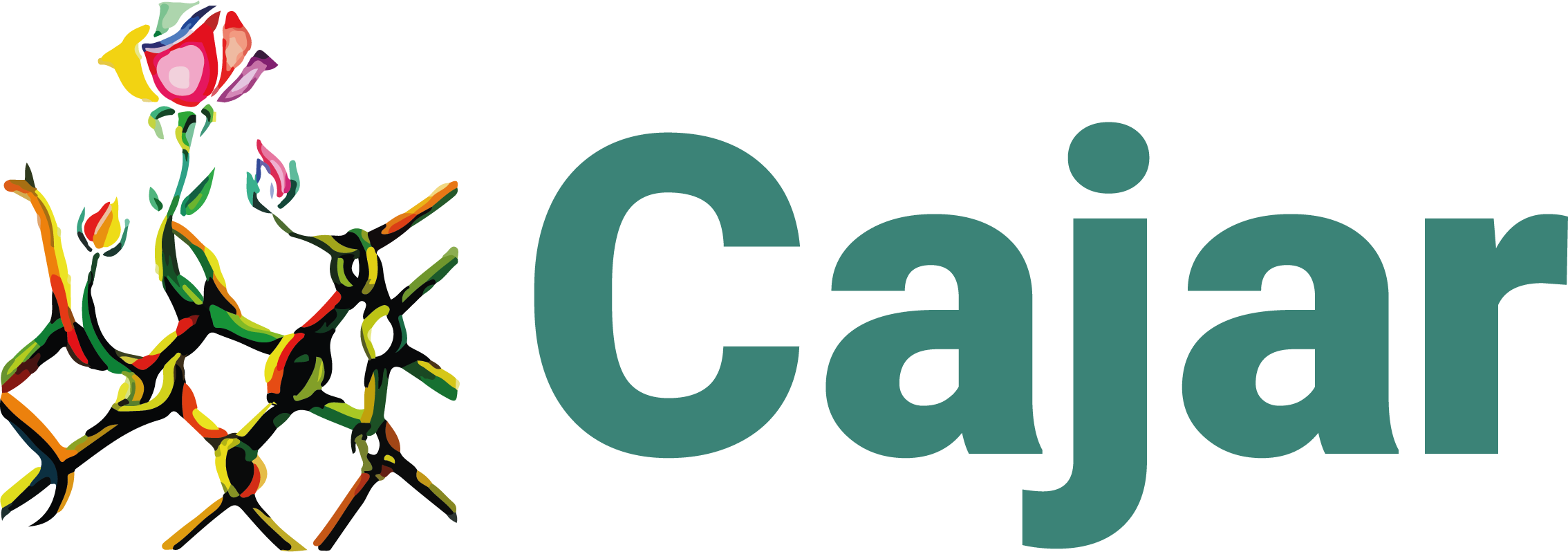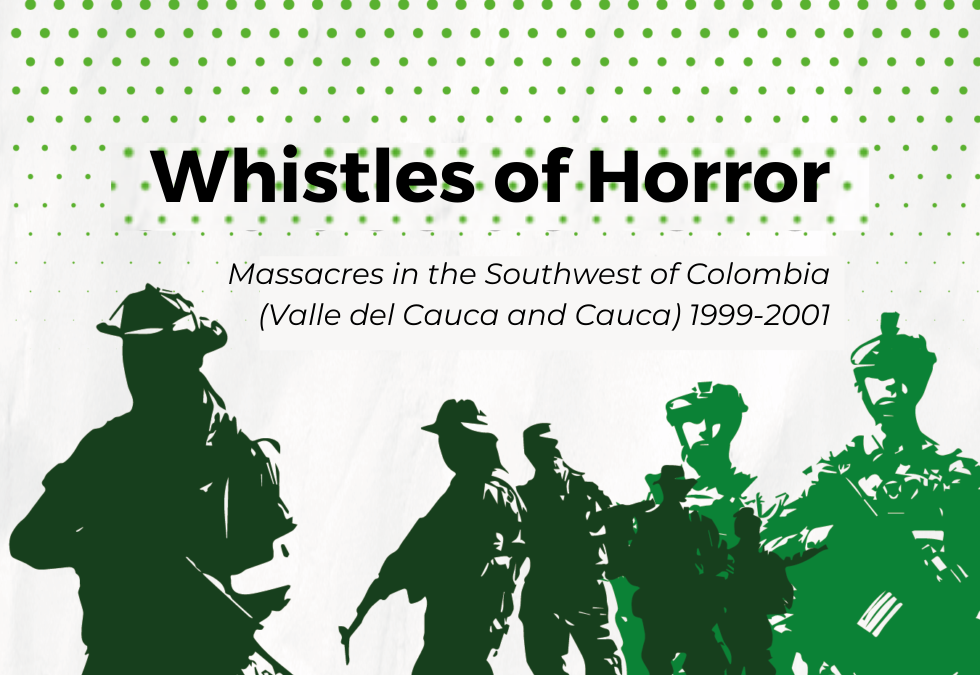- We ask that the region be prioritized in the new macro-case and that these events be declared crimes against humanity.
Units of the Third Brigade and the Third Division of the Colombian National Army were responsible by action or omission in 10 massacres that left 93 victims, committed by paramilitary groups between 1999 and 2001. This is the main conclusion drawn from the report Whistles of Horror: Massacres in the Southwest of Colombia (Valle del Cauca and Cauca) (1999-2001), presented by the José Alvear Restrepo Lawyers Collective to the Special Jurisdiction for Peace (JEP) on March 21.
The massacres documented here are, in the center of the Valley: El Placer, August 23, 1999, with five victims; San Pedro, September 12, 1999, with four victims; Barragán, December 19, 2000, 10 victims; Altaflor, December 24, 1999, five victims; and Alaska, October 10, 2001, with 24 victims. In northern Cauca: Los Recuerdos, November 23, 2000, 12 victims; Canoas, December 20, 2000, eight victims; La Rejoya, January 15, 2001, 10 victims; Gualanday, November 18, 2001, 13 victims; and Guachené, May 5, 2001, five victims.
Who were responsible?
The ten massacres were perpetrated directly by paramilitary groups of the self-styled Calima Bloc of the AUC, but were made possible by the support through action and omission provided by members of the Third Division and in turn Artillery Battalion No. 3 “Batalla de Palacé”, Engineer Battalion No. 3 “Agustín Codazzi” and Infantry Battalion No. 8 “Batalla de Pichincha” of the Third Brigade. Reference is also made to some civilian members of the State or not, who collaborated with the paramilitary consolidation in this territory.
The report -through which we ask the SJP to prioritize the departments that make up the Southwest region of Colombia in the phase of concentration of information in the macro-case to be opened for crimes committed by members of the security forces, other agents of the State or in association with paramilitary groups and civilian third parties- points out some alleged responsibilities that have already been investigated in the ordinary justice system. At the same time, it requests the Jurisdiction to investigate the complete composition of the senior staff of these units during the period corresponding to these events and to call them to appear or give voluntary testimony, in relation to their actions or omissions in the financing, training and delivery of weapons and intelligence to the paramilitary groups for the commission of the massacres.
To this end, it describes a preliminary structure so far identified of which they were part:
As Army Commander, retired General Jorge Enrique Mora Rangel. As commanders of the Third Division, Generals Rafael Horacio Ruiz and Jaime Humberto Cortez Parada. As commander of the Third Brigade, General Francisco René Pedraza and as Chief of Staff of the same unit, Colonel Julio Acosta Garay. As commanders of the Palace Battalion, Colonel Jorge Alberto Amor Páez and Colonel Rafael Alfonso Hani Jiménez. As commanders of the Agustín Codazzi Battalion, Julián Cardona and Elvert Vargas Castellanos – whose rank is unknown – the latter counter-guerrilla commander No. 2 attached to the Agustín Codazzi Battalion, a Captain with the last name Franco and a Sergeant with the last name Granados, members of the same unit. Colonel Tony Alberto Vargas Petécua, commander of the Pichincha battalion, together with Captain Mauricio Zambrano Castro and Corporal Antonio Castellanos, members of the same battalion.
In relation to the National Police commanders at the time of the events, it was established that the commanders in the jurisdictions of the different massacres were: Colonel Edgar Estupiñán, commander of the La Magdalena Police Station, Major Martín Emilio Navarro and Colonel José Benedicto Gómez Ruíz, commander of the Buga Police Station.
Also, Lieutenant Jairo Darío Pedraza, commander of the Del Valle Police, Lieutenant Diego Edison Mora Muñoz, commander of the Calima el Darién Police Station, as well as Carlos Ochoa Banguero, member of the National Police and alleged paramilitary informant, who was allegedly killed in the days prior to the “Los Recuerdos” Bar massacre.
Likewise, mention is made of the civilian third parties Célimo Bedoya, mayor of the municipality of San Pedro, and Guillermo Libreros, employee of the mayor’s office of San Pedro, Cauca, who are requested to be investigated because they held their positions during the period of the facts and the former paramilitaries have accused them of collaborating with the structure.
What did these massacres have in common?
From the identification of the common elements in these massacres, it was possible to establish that eight of the 10 were committed through paramilitary incursions of up to 85 armed men in the vicinity of the jurisdiction of military units of the National Army. For example, the massacre of El Placer, perpetrated in the municipality of Buga, where the base of the Army’s Palace Battalion is located, or the massacre of Alaska, where the same Battalion is located a maximum of 30 minutes from the place of the events.
The incursions also reflect that the civilian and police authorities did not react to the arrival and settlement of the paramilitaries in the municipalities where they could take hours and leave the municipalities incommunicado by damaging the telecommunications wiring. This is present in cases such as the massacre of El Placer, in the municipality of Buga, where at the end of the atrocities against the civilian population, the paramilitaries fought for at least 12 hours with the FARC-EP guerrillas without the Palace Battalion, being in the same municipality, having been present at the scene of the events.
Likewise, in the massacre of Los Recuerdos, in Santander de Quilichao, where 12 people were killed, in the same municipality where the Pichincha Battalion was located at that time under the command of Colonel Tony Alberto Vargas Petécua, who did not react to the paramilitary takeover. The same happened in the raid in Barragán, which involved the kidnapping of the population for 12 hours in the church.
In two of the events, in which an incursion was not carried out, the massacres were carried out by means of roadblocks. This was the case of the massacres of La Rejoya and Gualanday. In both cases, there is information that the Calima Bloc paramilitaries used guides or informants, possibly supplied by the security forces.
We also documented how the Palace Battalion in Buga, the Agustín Codazzi Battalion in Palmira, and the Pichincha Battalion in Santander de Quilichao, attached to the Third Brigade, which in turn is attached to the Third Division of the Army, were directly involved in the formation of the Calima Bloc, taking their responsibility far beyond omission. This according to versions of former members of the paramilitary structure that coincide with what was described by the U.S. human rights organization Human Rights Watch, which concluded that: “The Third Brigade is the Calima Bloc itself,” in its 2001 report Military-Paramilitary Relations and U.S. Policy in Colombia.
It also describes the prior knowledge that the authorities had of the paramilitary presence and how the high command of the Police and Army refused to take action against paramilitarism and instead denied credibility to the denunciations that had been made about the arrival of paramilitaries in the area, and statements by high-ranking military commanders are cited in this regard, such as that of General Jaime Humberto Cortez Parada who dismissed the existence of paramilitary groups in the area and the even more emphatic statements by Colonel Julio Acosta Garay in which he indicated that there were several factors that indicated that the situation was not due to the self-defense groups.
On the other hand, the report points out that these massacres were aimed at forced displacement and dispossession of territories. This logic of occupation, hand in hand with the security forces, developed the thesis of ‘taking the water out of the fish’ as a fundamental strategy of the war against the insurrection: “to take away the peasant support of the guerrillas”, states the report, and adds that “under this idea a close relationship between the peasantry and the guerrillas was cemented, which they tried to counteract by forcing the displacement of the peasants and establishing that those who stayed in the area were inevitably ‘civilian guerrillas’ “.
Along with this doctrine, the document includes elements of historical context in the Valley, such as the Trujillo Massacre, a precedent on the origin and expansion of paramilitarism and its alliances with drug trafficking in the region, as well as the close relationship of large economic emporiums and businessmen in the criminal activities of these groups, and cites the Justice and Peace ruling, which describes that businessmen, traders and politicians of the region participated in the origin and formation of the Calima Bloc, for whose responsibility there has been no progress in the ordinary justice system.
The general conclusion from the documentation of these events is that the paramilitary massacres were not isolated events that occurred in some specific regions and that, on the contrary, they were a mechanism for the consolidation of paramilitarism throughout the country as part of a plan directed from the institutional framework, which designed and allowed the implementation of a strategy of terror to eliminate sectors opposed to the State and the prevailing economic model.
Requests
For all of the above reasons, we request the prioritization of the departments of Valle del Cauca and Cauca in the aforementioned macro-case, in accordance with the macro-criminal analysis that evidences the identity of the facts with those that occurred in other areas of the country.
Likewise, that the process of accreditation be initiated and that the families of the persons listed in this report be recognized as victims, both those who were murdered, as well as those who were disappeared and forcibly displaced or victims of other types of crimes, and that all the necessary protection and security measures be implemented.
Likewise, declare the facts of the massacres documented in this report as Crimes against Humanity, open the phase of information gathering referred to in Article 27A of Law 1922 of 2019, and consequently call for voluntary testimonies from state agents of the security forces and the so-called third parties, by virtue of the facts narrated in this report.
We also request that the paramilitaries who have acknowledged their participation and those from whom it is possible to presume their responsibility in the events that are the subject of this report be called as witnesses.
Truth and justice regarding the role of the security forces in the origin and expansion of the paramilitary project are fundamental for the clarification of the facts under the jurisdiction of the Special Jurisdiction for Peace -JEP- and as a guarantee that events such as those that sowed terror in the southwest of Colombia and other areas of the country will never be repeated.
Here you can view and download the complete report (Language:Spanish)
Informe Suroccidente Final corregido 30322

